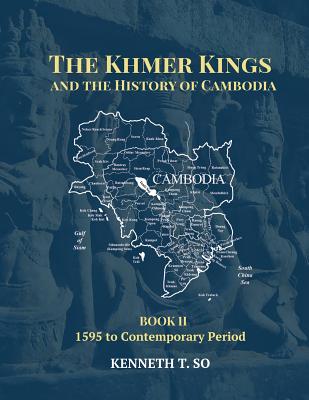The Khmer Kings and the History of Cambodia: BOOK II - 1595 to the Contemporary Period

The Khmer Kings and the History of Cambodia: BOOK II - 1595 to the Contemporary Period
The fall of Angkor did not provide the coup de grâce to Cambodia. The kingdom was still relatively strong after the Angkor period up until the fall of Longvek in 1594. After Naresuan had conquered Cambodia, he took back to Ayutthaya all the Khmer treasures such as sacred manuscripts, chronicles, books of code of laws, custom and tradition, skilled people, and a great number of Khmer families.
As the threat from Siam grew stronger, King Norodom who succeeded his father Ang Duong called on France for protection to thwart off Siam's hegemony. This period is called the French Protectorate Period which later turned into the Colonial Period. It started in 1863 and ended in 1953 after Cambodia obtained its independence from France on 9 November 1953 through the leadership of King Norodom Sihanouk.
The Colonial Period brought about the loss of Cochinchina, a Khmer territory under the French Protectorate. Unilaterally, France gave Cochinchina, which the Khmer calls Kampuchea Krom, to Vietnam on 4 June 1949. In a strange way, Cambodia owes France a great debt of gratitude for saving the country from extinction. The loss of Kampuchea Krom cannot totally be blamed on the French because the policy of Chey Chetha II and subsequent fratricidal wars between different branches of the royal family had allowed the Annamese/Vietnamese to settle in Cambodia in great numbers, and by 1949 the Vietnamese population had outnumbered that of the Khmers many folds. Due to civil wars and Annamese/Vietnamese's policies, Khmers living in Kampuchea Krom had to escape their birth place to come to central Cambodia which left more space for the Annamese/Vietnamese to occupy.
The Contemporary Period, which started after the independence of Cambodia from France, has gone through many regime changes such the Khmer Republic, the Democratic Kampuchea aka Khmer Rouge, People's Republic of Kampuchea under the occupation of the Vietnamese, and the current Kingdom of Cambodia.
The contemporary is discussed and analyzed in great detail in this book.
412.92Lei
412.92Lei
Livrare in 2-4 saptamani
Descrierea produsului
The fall of Angkor did not provide the coup de grâce to Cambodia. The kingdom was still relatively strong after the Angkor period up until the fall of Longvek in 1594. After Naresuan had conquered Cambodia, he took back to Ayutthaya all the Khmer treasures such as sacred manuscripts, chronicles, books of code of laws, custom and tradition, skilled people, and a great number of Khmer families.
As the threat from Siam grew stronger, King Norodom who succeeded his father Ang Duong called on France for protection to thwart off Siam's hegemony. This period is called the French Protectorate Period which later turned into the Colonial Period. It started in 1863 and ended in 1953 after Cambodia obtained its independence from France on 9 November 1953 through the leadership of King Norodom Sihanouk.
The Colonial Period brought about the loss of Cochinchina, a Khmer territory under the French Protectorate. Unilaterally, France gave Cochinchina, which the Khmer calls Kampuchea Krom, to Vietnam on 4 June 1949. In a strange way, Cambodia owes France a great debt of gratitude for saving the country from extinction. The loss of Kampuchea Krom cannot totally be blamed on the French because the policy of Chey Chetha II and subsequent fratricidal wars between different branches of the royal family had allowed the Annamese/Vietnamese to settle in Cambodia in great numbers, and by 1949 the Vietnamese population had outnumbered that of the Khmers many folds. Due to civil wars and Annamese/Vietnamese's policies, Khmers living in Kampuchea Krom had to escape their birth place to come to central Cambodia which left more space for the Annamese/Vietnamese to occupy.
The Contemporary Period, which started after the independence of Cambodia from France, has gone through many regime changes such the Khmer Republic, the Democratic Kampuchea aka Khmer Rouge, People's Republic of Kampuchea under the occupation of the Vietnamese, and the current Kingdom of Cambodia.
The contemporary is discussed and analyzed in great detail in this book.
Detaliile produsului










